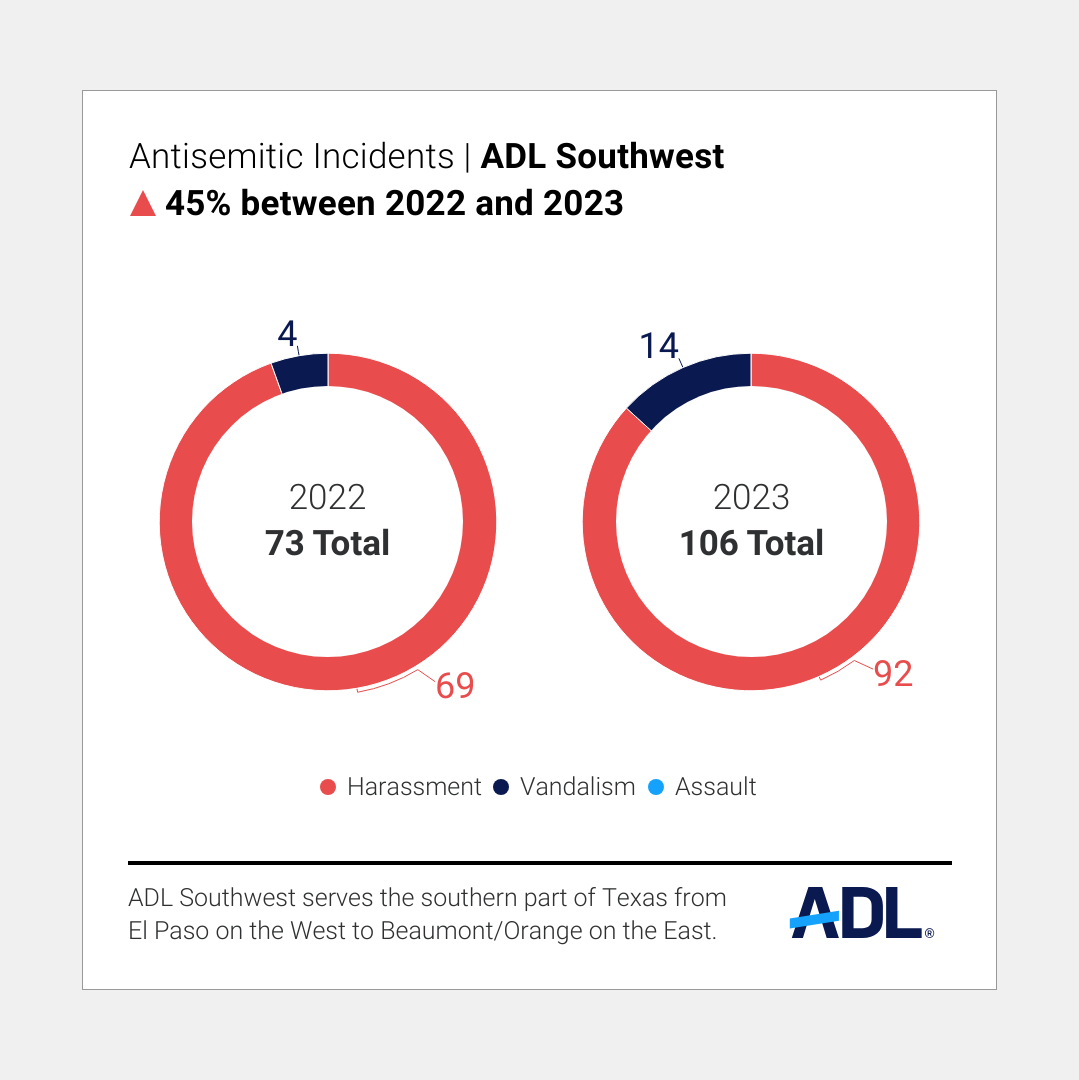
Driven in part by a massive spike in antisemitic incidents after the Oct. 7 massacre in Israel and the ongoing war in Gaza, the Jewish community in south Texas and the United States experienced an unprecedented increase in antisemitic incidents. ADL (the Anti-Defamation League) released the 2023 Audit of Antisemitic Incidents today and the data is staggering. ADL Southwest recorded 106 incidents of antisemitic assault, vandalism and harassment in 2023, soaring to 45 percent above the previous record of 73 set the previous year. Nationally, ADL recorded 8,873 incidents of antisemitic assault, harassment, and vandalism across the country: a 140-percent increase from 2022 and the highest level recorded since ADL started tracking this data in 1979.
The Southwest Region also recorded a 150 percent increase in antisemitic incidents, year-over-year, from October 7, 2022 through April 7, 2023, and October 7, 2023 through April 7, 2024, going from 28 incidents in the first six-month period to 70 incidents in the six-month period a year later. 61% (65) of the total number of incidents recorded from Houston to El Paso in 2023, occurred after October 7.
“Before October 7, we were encountering frightening numbers. It’s even more terrifying to know the majority of incidents followed the deadliest day for Jews since the Holocaust,” said Mark B. Toubin, ADL Southwest Regional Director. “Because incidents of antisemitism are usually a sign that other marginalized groups are feeling the negative impact of hate, we have to come together to address this growing problem.”
Nationally, there were 5,204 antisemitic acts post-Oct. 7, reflecting a global trend as Jewish communities worldwide face heightened tensions and hatred in response to the massacre and conflict – on campuses, in the public square and at anti-Israel demonstrations. With those incidents, the 12-month total for 2023 surpassed the totals of all the past three years combined and averaged about 24 anti-Jewish incidents in the U.S. per day.
ADL today called on governor’s offices across the country to create their own state-level versions of the White House’s landmark National Strategy to Counter Antisemitism, the first of its kind, a comprehensive effort to address antisemitism from across the political spectrum.
“Antisemitism is nothing short of a national emergency, a five-alarm fire that is still raging across the country and in our local communities and campuses,” said Jonathan Greenblatt, ADL CEO. “Jewish Americans are being targeted for who they are at school, at work, on the street, in Jewish institutions and even at home. This crisis demands immediate action from every sector of society and every state in the union. We need every governor to develop and put in place a comprehensive strategy to fight antisemitism, just as the administration has done at the national level.”
According to the ADL Center on Extremism, which leads Audit research and data collection, incidents increased in all three categories: Incidents of harassment surged by 184 percent compared to 2022; acts of vandalism rose 69 percent; and physical assaults jumped 45 percent.
Major Findings
In 2023, ADL counted antisemitic incidents in all 50 states and the District of Columbia. The Audit classifies incidents into three categories:
- Assaults: 161 incidents were categorized as assault, defined as cases where Jewish people (or people perceived to be Jewish) were targeted with physical violence accompanied by evidence of antisemitic animus. This was a 45 percent increase compared to 2022. Most antisemitic assaults (141 out of 161) were perpetrated without the use of a deadly weapon. Orthodox Jews were targeted in 34 percent of assault incidents nationally. The 161 incidents of assault targeted 196 victims, none of which were fatal.
- Harassment: 6,535 incidents were categorized as harassment, defined as cases where one or more Jewish people (or people perceived to be Jewish) were harassed with antisemitic slurs, stereotypes or conspiracy theories. Acts of harassment increased 184 percent, up from 2,298 incidents in 2022.
- Vandalism: 2,177 incidents were categorized as vandalism, defined as cases where property was damaged along with evidence of antisemitic intent or had an antisemitic impact on Jews. Acts of antisemitic vandalism increased 69 percent from the 1,289 incidents reported in 2022. Swastikas, which are generally interpreted as symbols of antisemitic hatred, were present in 1,117 of these incidents, up 41 percent from last year.
There were 1,987 incidents targeting Jewish institutions such as synagogues, Jewish community centers and Jewish schools, an increase of 237 percent from 589 in 2022. This significant increase was in part due to the dramatic spike in antisemitic bomb threats, the vast majority of which targeted synagogues in the fall. In total, synagogues experienced 73 percent of all incidents affecting Jewish institutions in 2023.
Antisemitic activity reported on college and university campuses increased by 321 percent from 2022. In non-Jewish K-12 schools, 1,162 incidents were reported, an increase of 135 percent.
The states with the highest number of incidents were California (1,266), New York (1,218), New Jersey (830), Florida (463) and Massachusetts (440). Combined, these five states accounted for 48 percent of the total incidents.
“Despite these unprecedented challenges, American Jews must not give in to fear,” Greenblatt said. “Even while we fight the scourge of antisemitism, we should be proud of our Jewish identities and confident of our place in American society. It may not feel so right now, but we have many more allies than enemies. And we call on all people of good will to stand with their Jewish friends and neighbors. We need your support and your allyship.”
White Supremacist Propaganda
The report also found an increase in activity by organized white supremacist groups, who were responsible for 1,161 antisemitic propaganda distributions last year – an increase from the 852 propaganda incidents attributed to white supremacist groups in 2022.
Bomb Threats and Swatting
Bomb threats toward Jewish institutions increased dramatically, with a total of 1,009 bomb threats – the highest number ever recorded and an increase of over 1,000 percent from 91 in 2022.
Additionally, swatting was increasingly used as a tactic to intimidate and harass minority communities, with 101 swatting incidents targeting Jewish institutions.
“The massive volume of incidents we documented in 2023 took many forms, including bomb threats and swatting campaigns, all aimed at terrorizing the community by disrupting services and activities at synagogues and other Jewish institutions across the country,” said Oren Segal, Vice President of the ADL Center on Extremism. “Our tracking of a swatting network, enabled ADL to offer crucial intelligence to law enforcement, ensuring accountability for perpetrators, while also preemptively alerting targeted communities and mitigating potential harm.”
Anti-Zionism and Incidents at Anti-Israel Protests
Of the 8,873 incidents in 2023, 3,162 (36 percent of the total) specifically contained elements referencing Israel or Zionism. This is significantly higher than the 241 incidents reported in 2022, which accounted for 6.5 percent of the total incidents.
Israel-related antisemitic incidents most often took place in public areas, with 1,540 incidents in locations like libraries, public transportation and on the streets. Another 644 Israel-related incidents took place on college and university campuses. Jewish institutions were targeted in Israel-related incidents on 377 occasions and 156 Israel-related incidents took place at K-12 schools.
Beginning immediately after Oct. 7, many anti-Israel organizations began protests and campaigns across the United States that continued through the end of 2023. The rhetoric used at these rallies included the promotion of classic antisemitic tropes, signage equating Judaism or Zionism with Nazism, unapologetic support for terrorism, glorification of terrorist groups and extreme anti-Zionism.
Methodology
The ADL Audit includes both criminal and non-criminal acts of harassment and intimidation, including distribution of hate propaganda, threats and slurs, as well as vandalism and assault. Compiled using information provided by victims, law enforcement and community leaders, and evaluated by ADL’s professional staff, the Audit provides a regular snapshot of one specific aspect of the Jewish-American experience while identifying possible trends in the types of activity reported.
The complete dataset for antisemitic incidents for 2016-2023 is available on ADL’s H.E.A.T. Map, an interactive online tool that allows users to geographically chart antisemitic incidents and extremist activity.
The Audit offers a snapshot of one of the ways American Jews encounter antisemitism, but a full understanding of antisemitism in the U.S. requires other forms of analysis as well, including public opinion polling, assessments of online antisemitism and examinations of extremist activity, all of which ADL offers in other reports, such as the ADL Survey of Antisemitic Attitudes in America 2024, Campus Antisemitism: A Study of Campus Climate Before and After the Hamas Terrorist Attacks, ADL Global 100, Online Hate and Harassment: The American Experience, Murder and Extremism and White Supremacist Propaganda.

